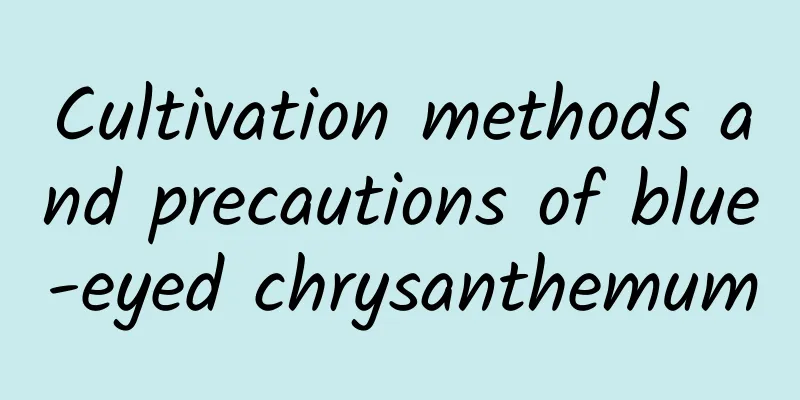Cultivation methods and precautions of blue-eyed chrysanthemum

|
If you like chrysanthemums, you might as well grow a blue-eyed daisy. It is beautiful and easy to grow. Its flowers are soft and elegant. Blue-eyed daisy, also known as African daisy, is native to South Africa and looks very similar to daisy. It is not cold-resistant, so except for the cold winter, it will bloom in spring, summer and autumn throughout the year, and the flowering period is more than 200 days. How to grow blue chrysanthemumBlue-eyed chrysanthemum can withstand low temperatures of -3 to 5 degrees, and is not afraid of the summer sun in the south. It has a strong root system and is free of diseases and pests. After buying it, change it to a larger pot, and then place it in the best sunny place, water it on time, and it will easily bloom out of the pot without pinching or topping. 1. Soil Blue-eyed chrysanthemum has a strong adaptability to the environment and can grow even in places with poor soil, high salt content or extreme water shortage. However, in order for it to grow better, it is usually necessary to prepare loose and fertile soil. If you prepare the potting soil yourself, you can mix loam and leaf mold, and add a certain amount of river sand to improve drainage capacity. 2. Lighting The growth of blue-eyed chrysanthemum cannot be separated from sufficient light. If the environment is too dark, the plant may grow too tall, which not only looks unsightly, but also affects flowering. It should be placed in a sunny place so that it can receive sufficient light. However, this plant is very afraid of heat and needs proper shade in summer to prevent it from being sunburned. 3. Watering Blue-eyed chrysanthemums must be watered enough to keep the soil moist. Once the plant lacks water, it will enter a dormant period, which may also cause the buds to fall off and affect its flowering. However, it should not be watered excessively. If the soil in the pot is too moist or there is water in it, it will also cause root rot. 4. Fertilization Before potting the blue-eyed chrysanthemum, sufficient base fertilizer should be applied to the soil. During its growth period, appropriate top dressing can be applied, or no fertilizer is required. However, before it blooms, some phosphorus and potassium fertilizers need to be added in advance, which can promote flowering. When applying fertilizer, you must pay attention to the concentration, as excessive fertilizer will cause fertilizer damage. Precautions for caring for blue chrysanthemumWhen caring for blue-eyed chrysanthemum, you should pay attention to the fact that after one year of growth, the nutrients in the soil in the flowerpot are basically consumed. At this time, you should replace it with new soil with sufficient nutrients. The side buds of blue-eyed chrysanthemum need to be cut off during the seedling stage to reduce nutrient consumption. When the buds are just beginning to form, you should choose to cut off the unnecessary buds to increase the amount of nutrients obtained by the remaining buds, so that the flowers that bloom will be larger and brighter. |
<<: The cultivation methods and precautions of hydroponics
Recommend
Can pregnant women drink water soaked with money grass? What are the benefits of drinking water soaked with money grass?
1. Can pregnant women drink it? Moneywort can be ...
What kind of flower pot is good for cactus?
What kind of flower pot is suitable for cactus Th...
How to grow cucumbers to get high yield?
Cucumbers are widely distributed in the north and...
Give the jasmine a few cuts and add some feed, and it can bloom five waves of flowers in a year!
prune 1. Trim off the withered flowers, count 2 t...
The efficacy and function of five elements grass
1. Antibacterial Five-element grass has antibacte...
The efficacy and function of coriander, how to make coriander delicious
1. The efficacy and function of coriander Lowers ...
The efficacy of leek seeds and how to eat leek seeds
1. Efficacy 1. Lubricates the intestines and prom...
Does rosemary like sun or shade? Does it like sunlight?
Does Rosemary prefer shade or sun? Rosemary has h...
Cherry Blossom Tree Growth Environmental Conditions and Characteristics
Cherry Blossom Tree Growth Environmental Conditio...
How often should I water the flying feather arrowroot?
How often should I water the flying feather arrow...
How to make the fortune tree sprout again and how to cultivate it after sprouting
1. How to re-sprout 1. Maintain the temperature: ...
Indoor cultivation methods and precautions for Milan
1. Breeding methods 1. Flower soil: It has very h...
Spring orchid varieties
1. Circle Petal type: plum petal History: Selecte...
The best time for Kalanchoe cuttings
1. Time for cuttings There is great flexibility i...
Does the pomegranate tree like the sun or the shade? Is it a shade-tolerant plant?
Does the pomegranate tree prefer shade or sun? Th...









